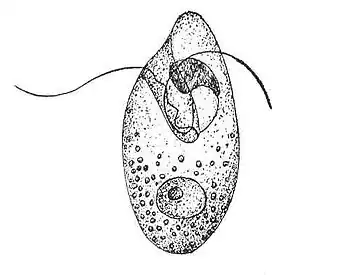Dinokaryon
A dinokaryon is a eukaryotic nucleus present in dinoflagellates in which the chromosomes are fibrillar in appearance (i.e. with unmasked DNA fibrils) and are more or less continuously condensed.

Nucleus with a dark nucleolus. The cell usually measures between 20 and 30 micrometers.
The nuclear envelope does not break down during mitosis, which is thus termed closed mitosis, or "dinomitosis".[1] The mitotic spindle is extranuclear.[2]
Histones are absent.[3] However, recent EST sequencing has revealed the presence of histones in one of the closest relative to dinoflagellates, Perkinsus marinus and an early-branching dinoflagellate, Hematodinium sp.[4] However, histone-like proteins of bacterial origins are found in the coding regions at periphery of the dinokaryon's chromosomes.[5]
References
- ↑ Gavelis, Gregory S.; Herranz, Maria; Wakeman, Kevin C.; Ripken, Christina; Mitarai, Satoshi; Gile, Gillian H.; Keeling, Patrick J.; Leander, Brian S. (2019-01-29). "Dinoflagellate nucleus contains an extensive endomembrane network, the nuclear net". Scientific Reports. 9 (1): 839. doi:10.1038/s41598-018-37065-w. ISSN 2045-2322. PMC 6351617.
- ↑ Gornik, SG; Hu, I; Lassadi, I; Waller, RF (8 August 2019). "The Biochemistry and Evolution of the Dinoflagellate Nucleus". Microorganisms. 7 (8). doi:10.3390/microorganisms7080245. PMC 6723414. PMID 31398798.
- ↑ FENSOME R.A., TAYLOR F.J.R., NORRIS G., SARJEANT W.A.S., WHARTON D.I. & WILLIAMS G.L. 1993. A classification of living and fossil dinoflagellates. American Museum of Natural History, Micropaleontology, Special Publication 7: 1-351.
- ↑ Gornik, S.G., Ford, K.L., Mulhern, T.D., Bacic, A., McFadden, G.I., and Waller, R.F.(2012). Loss of nucleosomal DNA condensation coincides with appearance of a novel nuclear protein in dinoflagellates. Curr. Biol. 22, 2303–2312
- ↑ Gavelis, Gregory S.; Herranz, Maria; Wakeman, Kevin C.; Ripken, Christina; Mitarai, Satoshi; Gile, Gillian H.; Keeling, Patrick J.; Leander, Brian S. (2019-01-29). "Dinoflagellate nucleus contains an extensive endomembrane network, the nuclear net". Scientific Reports. 9 (1): 839. doi:10.1038/s41598-018-37065-w. ISSN 2045-2322. PMC 6351617.
This article is issued from Offline. The text is licensed under Creative Commons - Attribution - Sharealike. Additional terms may apply for the media files.